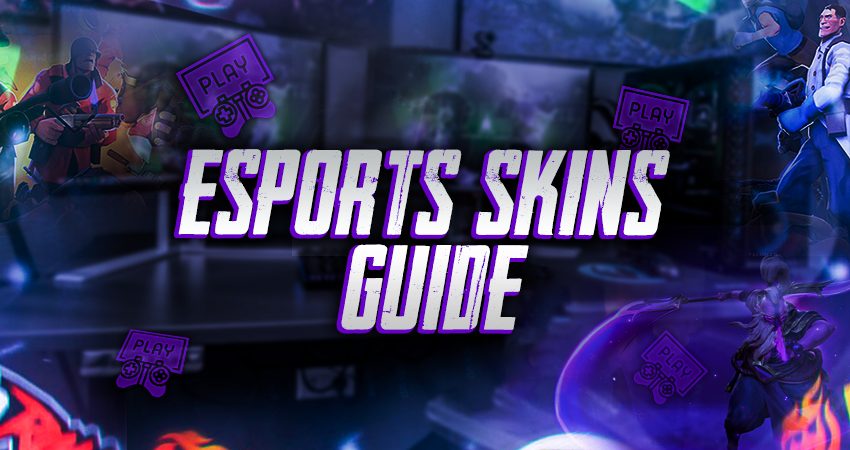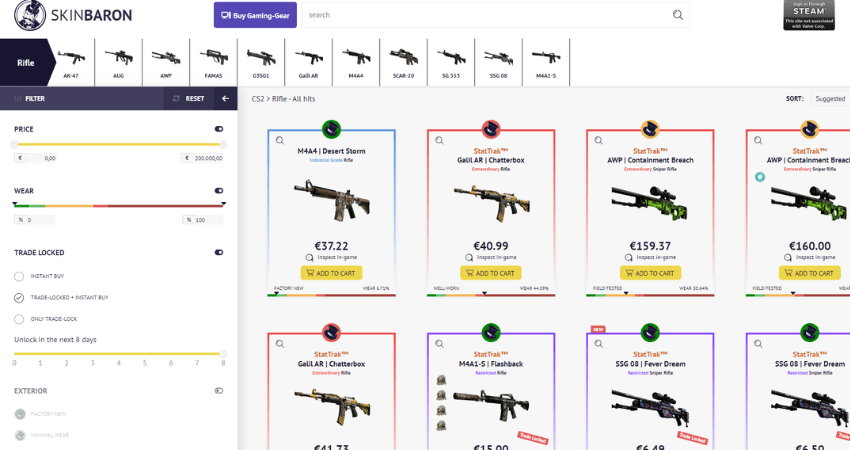ESports games have now become a major part of many people’s lives worldwide. Many gamers spend the majority of their free time playing eSports games. Because of the massive player base and the level of social interaction involved in eSports games, they have transitioned into much more than video games. ESports games have become virtual lives for many players.
In those virtual worlds, equipping in-game skins is one of the best ways to stand out and express your unique style. These eSports skins are in-game cosmetic items that change the look of your in-game character, equipment, and more.
However, the cosmetic items system can get confusing, with qualities, rarities, and other properties and terms people don’t know about. Here is a complete “eSports skins” guide to clarify some of the confusion and help you understand everything there is to know about eSports skins. This article was updated in 2025.
Key Takeaways
- eSports skins offer players a unique way to express themselves in virtual gaming worlds, turning cosmetic items into vehicles of personal style and identity.
- Gamers can acquire eSports skins through in-game stores, loot boxes, third-party marketplaces, and more, with each game offering distinct methods that cater to player preferences.
- Skins come with rarity tiers and qualities, allowing players to customize their characters and items with unique visuals, fostering a sense of rarity and exclusivity.
- The availability and tradeability of skins vary across games and platforms, impacting how players can obtain and trade these items according to the gaming ecosystem.
- Skin trading fosters interaction and community engagement among players, enabling them to exchange and connect over shared interests within the gaming world.
How to Get eSports Skins?
If you are tired of using default skins while playing your favorite eSrpots game, you can get a few eSports skins to help make things fresh. But where can you get eSports skins? Fortunately, there are multiple methods of acquiring eSports skins.
However, it depends a lot on the video game. Some games have just one method, while others have multiple methods. We’ll discuss each game’s specific method for letting players acquire skins in a later section. Here are all the most common methods players can use to acquire eSports skins.
In-Game Stores
Almost all games have in-game stores. Think of them as virtual stores that sell in-game items, including skins. These in-game stores can be accessed right from the game’s home screen. Players can purchase skins at an in-game store through real cash, the in-game currency earned by playing the game, or the premium in-game currency they purchased with cash.
In-game stores might offer only some of the skins available in the game. Players might have to check out other methods to acquire the skins that aren’t available on the in-game store. However, for some games, the in-game store is the only option.
Steam Community Market
Skins for certain eSports games, ones that have either been developed by Valve or have Steam tradable in-game items, can also be bought from the Steam Community Market. The Steam Community Market is an online marketplace for in-game items and skins players no longer need. Gamers can list their unwanted items on the Steam Community Market for others to see, and anyone can go through all the listings and then purchase whatever item they like using funds from their Steam wallet.
Loot Boxes
One of the most popular ways to acquire eSports skins is through the in-game loot box system. Almost all games have some loot box system with a different name. For example, CS2 has cases, and Team Fortress 2 has Supply Crates.
Using loot boxes to acquire skins is a very simple process. First, you need the loot box. You either get these loot boxes as free drops or by purchasing them. Depending on the game, you can purchase a loot box from the Steam Community Market or the in-game store with the in-game currency acquired by playing or simply purchasing.
Once you have acquired a loot box, you have to open it. For some games, like CS2, you might need a key to open the loot box. After getting everything necessary for opening the loot box, open it, and a roulette-style animation will spear on your screen with different skins as prizes. At the end of the animation, you receive an eSports skin, depending on where the roulette spin lands, which is completely random.
Some games have only one type of loot box for players to open. On the other hand, certain games have multiple varieties of loot boxes. The type of loot box you open will determine the possible skins you can get from it. However, getting the precise skin you want is not guaranteed since it is completely random.
In-Game Drops/ Challenges/ Progression
Games also reward gamers for playing the game with skins. Games usually do this in three main ways: free drops, challenges, and progressions. Almost all games have either one or more of these. First up, we have free drops. When you play certain eSports games, you can get a random skin as a free drop, usually at the end of a match. However, the specifics of this in-game drop system vary from game to game.
Up next, we have the challenges. Certain games will reward players for completing specific tasks within the game. These challenges can be introduced for events like Christmas or Halloween. Or, they can also be a permanent part of the game.
Some games also have progression systems that reward players with skins for reaching certain milestones. These milestones can include reaching certain levels or weapon mastery. The most popular progression reward-based model is the battle pass. Players play the game to gain points that unlock levels on the battle pass, with each level granting players a skin or any other in-game cosmetic item. Gamers are also given challenges they can complete to gain more points for the battle pass levels.
Third-Party Marketplaces
Another popular method used for acquiring eSports skins is third-party marketplaces. These online platforms have no connection with the game or developers and sell eSports skins for cash. However, not all games have skins that can be bought from third-party marketplaces. On these online platforms, you can only find skins that are tradable.
Using third-party platforms instead of the methods mentioned above has multiple benefits. Third-party platforms offer much better pricing than in-game stores or the Steam Community Market. Secondly, these platforms sometimes have the rarest skins that can’t be found anywhere else. Lastly, you can also sell your skins for real cash on these platforms.
However, since almost anyone can open a third-party marketplace website for eSports skins, getting scammed is something that you should be very careful of while buying skins from a third-party marketplace. While there are multiple platforms that provide legit services, there are some that are just there to steal your money.
The worst part is that scam sites do such a great job presenting themselves as legit that figuring out the legit ones and removing the ones that aren’t becomes difficult. Fortunately, we’ve already done that for you and created lists of the best third-party marketplaces for games like CS2, Rust, Team Fortress 2, and Dota 2.
Trading eSports Skins
Imagine if there was a way through which you could get rid of eSports skins that you no longer want while getting some newer eSports skins in return. That’s precisely what eSports skins trading allows you to do.
For example, a friend of yours has some skins they don’t like, but you really like them. On the other hand, you have some skins you don’t find attractive, but your friend wants them. You both make a trade and get the skins you like.
Steam has a built-in system called the trade window that allows Steam users to trade with each other. However, keep in mind that not all games have tradable skins. Check out our complete eSports skins trading guide to learn more about eSports skins trading.
Rarity and Other Qualities of eSports Skins
Not all eSports skins are alike, even within one video game. Some are more attractive, with intricate designs and unique visual effects. Therefore, these skins are rarer than regular ones and also more expensive. To help gamers identify which ones are rarer than others, eSports skins are classified into rarity tiers.
Along with that, esports skins also have other qualities tied to them. These qualities or classifications help determine the type of skin. For example, a particular skin can only be for the weapons, while some other skin can be for the entire in-game character.
Qualities assigned to skins and their rarity tiers depend on the video game. Some games have multiple rarity tiers and qualities for cosmetic items. At the same time, others may include just a single set of rarity tiers.
eSports Titles and their Skins
To help simplify things, here is a list of all popular eSports skins classified by video games, where we have listed rarity tears, specific qualities, and other classifications for each. We have also included whether skins for the particular game are tradable and where you can buy skins for that particular game.
CS2 Skins
CS2 skins are tradable. You can acquire CS2 skins from cases, the Steam Community Market, free drops, and third-party marketplaces. CS2 skins have exterior wear conditions, rarity tiers, and several other classifications.
Skin Condition and Float Value:
- Factory New (0.00 to 0.07)
- Minimal Wear (0.07 to 0.15)
- Field-Tested (0.15 to 0.37)
- Well-Worn (0.37 to 0.44)
- Battle-Scarred (0.44 to 1.00)
Rarity Tiers
- Consumer Grade, Common, Base Grade (White)
- Industrial Grade, Uncommon (Light Blue)
- Mil-Spec Grade, Rare, High Grade (Darker Blue)
- Restricted, Mythical, Remarkable (Purple)
- Classified, Legendary, Exotic (Pinkish Purple)
- Covert, Ancient, Extraordinary (Red)
- Exceedingly Rare, Rare Special (Gold)
- Contraband, Immortal (Light Orange)
Other Classifications
- StatTrak Skins
- Souvenir Skins
- Stickers
- Gloves
- Agent Skins
Dota 2 Skins
Dota 2 skins are tradable. You can acquire Dota 2 skins from Treasures, the in-game shop, the Steam Community Market, free drops, and third-party marketplaces. Dota 2 skins have qualities, rarities, and several other classifications.
Main Cosmetic Item Classification
- Equipment
- Couriers
- Wards
- Taunts
- Announcers
- Terrains
Rarity
- Common
- Uncommon
- Rare
- Mythical
- Legendary
Quality
- Normal
- Genuine
- Elder
- Unusual
- Self-made
- Inscribed
- Cursed
- Heroic
- Favored
- Ascendant
- Autographed
- Legacy
- Exalted
- Frozen
- Corrupted
- Auspicious
- Infused
- Completed
- Valve
- Community
- Standard
- Customized
Other Rarities
- Immortal
- Arcana
- Personas
Team Fortress 2 Skins
Team Fortress 2 skins are tradable. You can acquire Team Fortress 2 skins from the in-game store (Mann Co. Store), crates, the crafting system, the Steam Community Market, free drops, and third-party marketplaces. Team Fortress 2 skins have item qualities, grades, and exterior wear conditions.
Item Quality
- Normal
- Unique
- Vintage
- Genuine
- Strange
- Unusual
- Haunted
- Collector’s
- Decorated
Grades
- Civilian (Light Blue)
- Freelance (Blue)
- Mercenary (Dark Blue)
- Commando (Purple)
- Assassin (Pink)
- Elite (Red)
Wear and Exterior Condition
- Factory New
- Minimal Wear
- Field-Tested
- Well-Worn
- Battle-Scarred
Rust Skins
Rust skins are tradable. You can acquire Rust skins from the in-game store (Item Store), crates, the Steam Community Market, free drops, and third-party marketplaces. Rust skins are primarily classified according to the items they are applied onto.
Skin Types
- Weapons
- Attire/Wearables
- Tools
- Construction
- Misc
Valorant Skins
Valorant skins are not tradable. You can only acquire Valorant skins through the in-game store with premium in-game currency purchased with real cash. You can also acquire skins for free by completing Agent challenges. Valorant skins are primarily classified into tiers based on how much VALORANT Points (VP) (the premium in-game currency) are required to purchase them.
Skin Tiers and Cost
- Select Edition (SE): 875 VP
- Deluxe Edition (DE): 1275 VP
- Premium Edition (PE): 1775 VP
- Ultra Edition (UE): Varies
- Exclusive Edition (XE): Varies
League of Legends Skins
League of Legends skins are not tradable. You can acquire League of Legends skins by purchasing them from the in-game store, opening chests, completing challenges, winning tournaments, and receiving season rewards. League of Legends skins are primarily classified into tiers with colors associated with each tier.
Skin Tiers
- Ultimate (Gold)
- Mythic (Purple)
- Legendary (Red)
- Epic (Blue)
- Standard (Green)
- Budget (White)
- Timeworn (Gray)
PUBG Skins
Certain PUBG skins are tradable. You can acquire PUBG skins by opening crates and purchasing from the Steam Community Market or third-party marketplaces. You can also get skins for completing in-game challenges. PUBG skins are primarily classified into rarity tiers with colors associated with each tier.
Skin Tiers
- Classic (Gray)
- Special (Green)
- Rare (Blue)
- Elite (Violet)
- Epic (Purple)
- Legendary (Red)
- Ultimate (Gold)
Fortnite Skins
Fortnite skins are not tradable. You can acquire Fortnite skins by purchasing them from the in-game store and completing the battle pass. Fortnite skins are primarily classified into tiers with colors associated with each tier. Plus, there are several skin types in Fortnite.
Skin Tiers
- Handmade (White)
- Common (Gray)
- Uncommon (Green)
- Rare (Blue)
- Epic (Purple)
- Legendary (Orange)
- Mythic (Gold)
- Exotic (Light Blue (Edge) Cyan (Center))
- Transcendent (Light Red)
- Marvel Series (Dark Red)
- Dark Series (Magenta)
- DC Series (Grey-Blue)
- Icon Series (Cyan)
- Frozen Series (Light Blue)
- Lava Series (Dark Orange)
- Star Wars Series (Dark Blue and Yellow)
- Shadow Series (Black)
- Slurp Series (Dark Cyan)
- Gaming Legends Series (Indigo)
Skin Types
- Outfits
- Emotes
- Pickaxes
- BackBlings
- Gliders
- Wraps
- Loadings
- Music
- Contrails
- Sprays
- Emojis
- Toys
- Banners
Conclusion
Getting eSports skins is the best way to add your own unique flavor to your favorite game. Now, you know everything there is to know about eSports skins and are ready to grab your first one. Go through all the rarity tiers and qualities mentioned above so you know the precise value of the skins you have or are planning to acquire.
FAQ
What are eSports skins?
eSports skins are in-game cosmetic items that alter the appearance of characters, equipment, and more in eSports games, allowing players to personalize their virtual identities.
How can I acquire eSports skins?
You can acquire eSports skins through various methods such as in-game stores, loot boxes, in-game drops, challenges, third-party marketplaces, and trading.
Are eSports skins tradable?
Yes, some games allow skin trading between players, enabling them to exchange skins to get the ones they desire.
What determines the value of an eSports skin?
The value of a skin is determined by its rarity tier, quality, uniqueness, and demand among players.
Are third-party marketplaces safe for purchasing skins?
While some third-party marketplaces offer legitimate services, caution is advised due to the risk of scams. Stick to reputable platforms and research before making purchases.
Can I use the same skins across different platforms?
The ability to use skins across platforms depends on the game and its cross-platform compatibility. Not all games allow this feature.
What is the significance of rarity tiers and qualities?
Rarity tiers and qualities categorize skins based on their uniqueness and appearance, affecting their desirability and perceived value.
How do eSports skins impact the gaming community?
eSports skins promote individuality and creativity among players, while also fostering a sense of community through trading and shared interests.
Can I customize the appearance of characters and items in all eSports games?
Customization options vary between games. Some offer a wide range of skins, while others might have limited cosmetic choices.
What role do eSports skins play in the gaming industry?
eSports skins represent a convergence of gaming, fashion, and virtual economy, contributing to the gaming culture and industry’s dynamic growth.


























